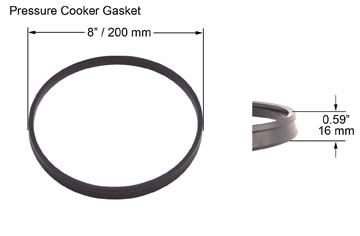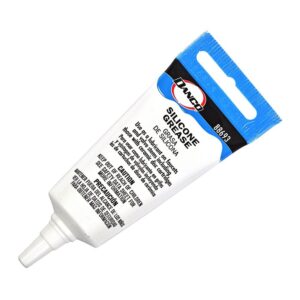We sell quite a few of the Revere Ware vintage pressure cooker gaskets.

Occasionally, we get complaints that the gaskets don’t seal properly. Here is a checklist of things to try before you consider returning the gasket to us.
Is the gasket installed correctly
Due to how they are manufactures, the gaskets come to us inside out, and that is how we ship them. Inside out means the notched side, which matches up with the lip in the lid, is on the inside (but needs to be on the outside). So the first step is to make sure the gasket is right-side out.
It is essential that the notch in the gasket site below the lip of the lid. Here are some useful graphics:


(Note that if you are having trouble getting the gasket installed, and it seems almost too big, try soaking it in some hot water to make it more pliable.)
Is the pressure cooker warped
If your pressure cooker is warped, the top can be out of round. This will cause steam to escape in certain spots around the rim of the lid.
Use a ruler or tape measure to measure across the top of the pressure cooker pot as close to across the center as you can. Measure in a few different spots. Each measurement should be exactly the same. If it is off, even by as little as 1/8 of an inch, your pressure cooker is warped and likely won’t seal well.
Note that as silicone ages, it swells. Old gaskets can sometimes work on a warped pressure cooker while a new one won’t. Your old gasket might be hiding the problem that isn’t apparent until you try a new gasket.
Is the gasket defective
Closely inspect the parts of the gasket that come into contact with the lid. Are there some injection molding artifacts hanging off of it? If so, try to gently pull them off. Are there any divots in the gasket? If so, this is a defect and could cause leaking. Let us know and we will replace it.
Has the latch metal bent?
The lid has a metal hook piece at the front underside of the handle. If this metal has gotten bent outward, it won’t apply enough downward pressure on the lid and thus the gasket. This could cause leaking. These pictures show this latch metal:

If you press the two handles together and the leak stops, this could be the problem. We’ve never tried it, but presumably you can try to bend it back down so the lid sits tighter when latched.
None of the above is true but it still leaks
If it is correctly positioned, your pressure cooker is not warped, and the gasket is not defective, there are still a couple of things you can try.
The first is to apply a thin coat of vegetable oil to the gasket before you put it in the lid. Oil will cause the gasket to swell slightly.
Second, you can try some silicone lubricant, like this type from Amazon.com.

The product listing does seem to indicate that this lubricant is food grade.

ıs ıt safe to replace the gasket wıth RTV sılıcone? ıs there any chance the pressure cooker wıll explode or ıs the only problem that ıt wouldnt seal correctly and just leak? thanks
I’m not sure I’m entirely qualified to answer your question with authority, but I will try. Use my advice at your own risk.
Make sure you are using food grade RTV silicone. If all you are doing is using the silicone to create a seal like the gasket does, I don’t see any reason why it would cause a problem. All pressure cookers have a pressure release mechanism if the pressure gets too high; as long as that is functional, you should be safe.